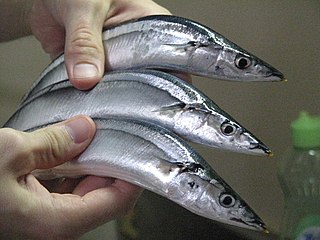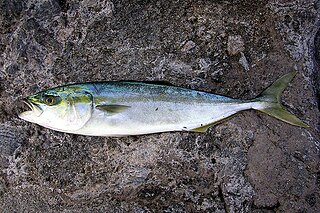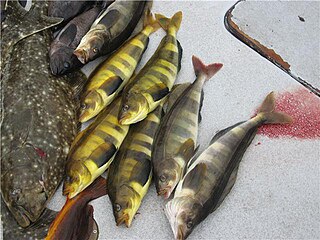
Mackerel is a common name applied to a number of different species of pelagic fish, mostly from the family Scombridae. They are found in both temperate and tropical seas, mostly living along the coast or offshore in the oceanic environment.

The Scorpaeniformes are a diverse order of ray-finned fish, including the lionfishes and sculpins, but have also been called the Scleroparei. It is one of the five largest orders of bony fishes by number of species, with over 1,320.

Chikuwa (竹輪) is a Japanese fishcake product made from fish surimi. After being mixed well, they are wrapped around a bamboo or metal stick and steamed or broiled. The word chikuwa comes from the shape when it is sliced.
Indo-Pacific king mackerel, also known as the spotted seer fish or spotted Spanish mackerel, is a sea fish among the mackerel variety of fishes. It is found in around the Indian Ocean and adjoining seas. It is a popular game fish, growing up to 45 kg (99 lb), and is a strong fighter that has on occasion been seen to leap out of the water when hooked.

The Pacific saury is species of fish in the family Scomberesocidae. Saury is a seafood in several East Asian cuisines and is also known by the name mackerel pike.

The double-lined mackerel, is a species of Spanish mackerel in the family Scombridae. This species is sometimes also called the scad mackerel.

Hexagrammidae, the greenlings, is a family of marine ray-finned fishes belonging to the suborder Cottoidei in the order Perciformes. These fishes are found in the North Pacific Ocean.

Pelagic fish live in the pelagic zone of ocean or lake waters—being neither close to the bottom nor near the shore—in contrast with demersal fish that live on or near the bottom, and reef fish that are associated with coral reefs.

The Japanese amberjack or yellowtail, Seriola quinqueradiata, is a species of jack fish in the family Carangidae, native to the northwest Pacific Ocean. It is known as shiyu (鰤魚) in China, bang'eo (방어) in Korea, and buri or hamachi in Japan.

The Australian bonito, horse mackerel or little bonito, Sarda australis is a ray-finned fish of the family Scombridae and is found in eastern Australia and New Zealand. They swim at depths reaching depths of approximately 30 m (98 ft), in open water. Its length is commonly at around 40–45 centimetres (16–18 in) fork length and 1.8–2.3 kilograms (4.0–5.1 lb) weight. Its maximum length and weight are about 100 centimetres (39 in) and 9.4 kilograms (21 lb), respectively.

Satsuma-age (薩摩揚げ) is a fried fishcake originating from Kagoshima, Japan. Surimi and flour is mixed to make a compact paste that is solidified through frying. It is a specialty of the Satsuma region. It is known by a variety of regional names throughout Japan.

The scale-eye plaice is a species of flatfish in the family Pleuronectidae. It is a demersal fish that lives at depths from between 18 metres (59 ft) to 900 metres (3,000 ft). It can reach 46 centimetres (18 in) in length and can weigh up to 1.2 kilograms (2.6 lb). Its native habitat is the northern Pacific, primarily from the Sea of Okhotsk to Japan and Korea, though it is also found in the Bering Sea.

Chloroscombrus is a genus containing two species of tropical to temperate water marine fish in the jack and horse mackerel family Carangidae. Both members are commonly known as bumpers or bumperfish, with one species endemic to the Atlantic and the other to the eastern Pacific. They have a convex ventral profile compared to most other carangids, with small oblique mouths and low dorsal and anal fins. Phylogenetic studies have found they are most closely related to the jacks of the genus Hemicaranx, with these genera plus Selar, Selaroides and possibly Alepes, making up a clade within the Caranginae subfamily. They are predatory fish which live in both inshore and offshore environments ranging from estuaries to the edge of the continental shelf, and are of moderate importance to fisheries.

An anchovy is a small, common forage fish of the family Engraulidae. Most species are found in marine waters, but several will enter brackish water, and some in South America are restricted to fresh water.

The Atka mackerel is a mackerel in the family Hexagrammidae. Atka mackerel are common in the northern Pacific Ocean, and are one of only two members of the genus Pleurogrammus – the other being the Arabesque greenling. The Atka mackerel was named for Atka Island, the largest island of the Andreanof islands, a branch of the Aleutians.

Plaice is a common name for a group of flatfish that comprises four species: the European, American, Alaskan and scale-eye plaice.

The Indian mackerel or bigmouth mackerel is a species of mackerel in the family Scombridae. It is commonly found in the Indian and West Pacific oceans, and their surrounding seas. It is an important food fish and is commonly used in South and South-East Asian cuisine.

Pleurogrammus is a genus of ray-finned fishes belonging to the family Hexagrammidae, the greenlings, known as Atka mackerels. These fishes are found in the northwestern Pacific Ocean.

Insidiator is a genus of marine, demersal ray-finned fish belonging to the family Platycephalidae. These fishes are native to the eastern Indian Ocean and western Pacific Ocean.
Cyclopteropsis bergi is a species of lumpfish native to the Northwest Pacific, where it is found at depths of 20 to 200 m. This species reaches 7 cm in total length and occurs in the Bering Sea, the Sea of Okhotsk, and the Sea of Japan where it may be found off of North Korea and Sado Island. In 2011, a single individual of the species was also reported from Sokcho, South Korea.






















